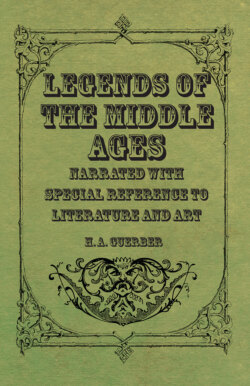Читать книгу Legends of the Middle Ages - Narrated with Special Reference to Literature and Art - H. A. Guerber - Страница 8
На сайте Литреса книга снята с продажи.
ОглавлениеPREFACE.
The object of this work is to familiarize young students with the legends which form the staple of mediaeval literature.
While they may owe more than is apparent at first sight to the classical writings of the palmy days of Greece and Rome, these legends are very characteristic of the people who told them, and they are the best exponents of the customs, manners, and beliefs of the time to which they belong. They have been repeated in poetry and prose with endless variations, and some of our greatest modern writers have deemed them worthy of a new dress, as is seen in Tennyson’s “Idyls of the King,” Goethe’s “Reineke Fuchs,” Tegnér’s “Frithiof Saga,” Wieland’s “Oberon,” Morris’s “Story of Sigurd,” and many shorter works by these and less noted writers.
These mediaeval legends form a sort of literary quarry, from which, consciously or unconsciously, each writer takes some stones wherewith to build his own edifice. Many allusions in the literature of our own day lose much of their force simply because these legends are not available to the general reader.
It is the aim of this volume to bring them within reach of all, and to condense them so that they may readily be understood. Of course in so limited a space only an outline of each legend can be given, with a few short quotations from ancient and modern writings to illustrate the style of the poem in which they are embodied, or to lend additional force to some point in the story.
This book is, therefore, not a manual of mediaeval literature, or a series of critical essays, but rather a synopsis of some of the epics and romances which formed the main part of the culture of those days. Very little prominence has been given to the obscure early versions, all disquisitions have been carefully avoided, and explanations have been given only where they seemed essential.
The wealth and variety of imagination displayed in these legends will, I hope, prove that the epoch to which they belong has been greatly maligned by the term “dark ages,” often applied to it. Such was the favor which the legendary style of composition enjoyed with our ancestors that several of the poems analyzed in this volume were among the first books printed for general circulation in Europe.
Previous to the invention of printing, however, they were familiar to rich and poor, thanks to the scalds, bards, trouvères, troubadours, minstrels, and minnesingers, who, like the rhapsodists of Greece, spent their lives in wandering from place to place, relating or reciting these tales to all they met in castle, cottage, and inn.
A chapter on the Romance literature of the period in the different countries of Europe, and a complete index, will, it is hoped, fit this volume for handy reference in schools and libraries, where the author trusts it may soon find its own place and win a warm welcome.
